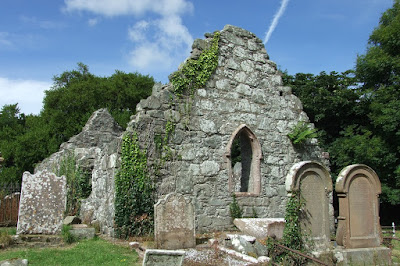TULLYNAKILL, a parish on the eastern border of the barony of Lower Castlereagh, 3¼ miles south-east by south of Comber, County Down.
It contains the village of Ardmillan.
Its length, south-south-eastward, is 2¾ miles; its breadth, exclusive of its portion of Strangford Lough, is 2 miles; but its breadth, inclusive of its portion of Strangford Lough, becomes its length, and is 3 miles; and its area, 2,923 acres.
The surface lies along the west shore of Strangford Lough; consists, in general, of prime land; and is traversed across the west wing by the road from Newtownards to Killyleagh.
Some large limestone quarries, in which fossil remains abound, are extensively worked; the stone resembles porphyry, and is conveyed both by land and water to all parts of the surrounding country.
 |
| Tullynakill Vicarage (Image: Rev Dr Stanley Gamble) |
A manorial court with extensive jurisdiction and peculiar privileges was formerly held here, but it has fallen into disuse for many years.
The breadth of the strand of Strangford Lough within Tullynakill, or of the portion of its bed which is alternately covered and forsaken by the tide, varies from ½ mile to very nearly 2 miles; and the isles and islets either within this strand, or on its seaward margin, are Wood Island, Watson's Island, Gull Rock, Downey's Rock, Bird Island, Duck Rock, Long Island, Rolly Island, Reagh Island, Calf Rock, Horse Island, and Mahee Island - the last inhabited and comparatively large.
In the northern district, adjacent to the strand, are some limestone quarries.
 |
| Tullynakill Parish Church; demolished in 1970 (Image: Rev Dr Stanley Gamble) |
This parish is a vicarage, and a separate benefice, in the diocese of Down.
The incumbent also holds the united benefices which constitute the corps of Kilroot prebend in the cathedral of Connor; and is non-resident in Tullynakill.
The rectorial tithes belong to the see of Down; but the whole parish being bishop's land, no composition for these tithes appears to have been made.
A curate receives a salary of £69 4s 7½d [about £8,500 in 2020].
 |
| Tullynakill Old Church (Image: Ards & North Down Borough Council) |
The [new] church was built in 1825, by means of a gift of £830 15s 4½d [about £103,000 in 2020] from the Board of First Fruits.
The ruins of the old church, built, or according to some accounts rebuilt, in 1636 [1639], are still visible.
In 1868 the parishes of Tullynakill and Kilmood were united.
The united parishes of Kilmood and Tullynakill were combined with that of Killinchy in 1923.
The Georgian church was deconsecrated and demolished in 1970 due to dwindling congregations; so, ironically, the ruins of the 17th century church have outlived its successor.
The graveyard contains the grave of John McWilliams, killed at the Battle of Ballynahinch.
First published in March, 2021.



1 comment :
I had a walk around the old church site, it really needs tidying before any more damage done by overgrowth of ivy etc. so sad it’s been obviously forgotten and ignored by those who are supposed to be in charge of maintaining it
Post a Comment